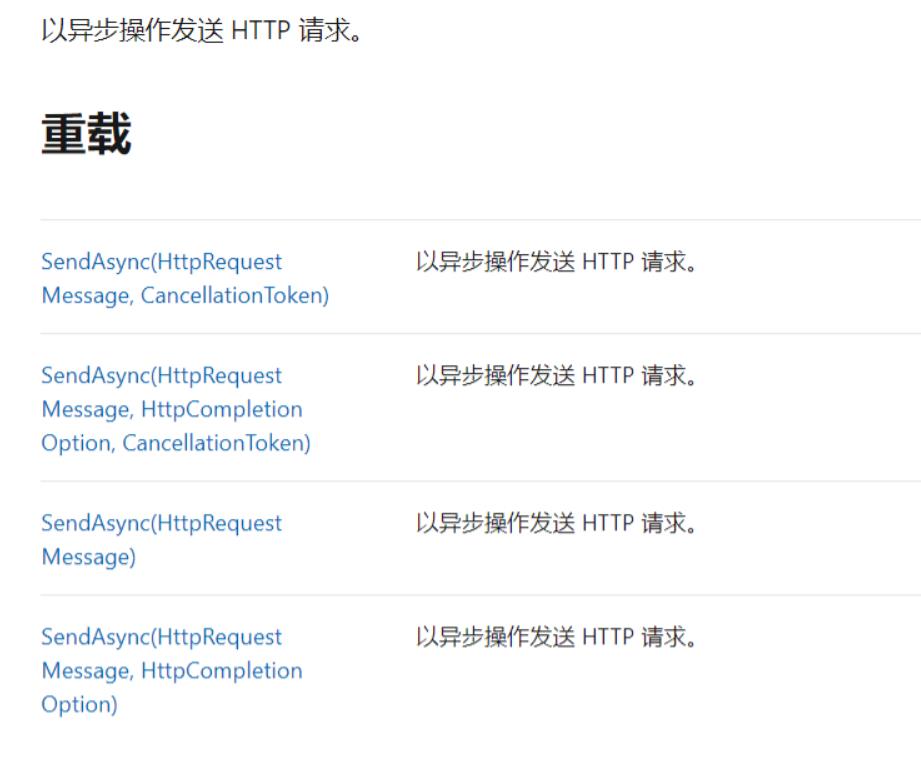C# HttpClient请求及数据传输
痴者工良 人气:0一,授权认证
客户端请求服务器时,需要通过授权认证许可,方能获取服务器资源,目前比较常见的认证方式有 Basic 、JWT、Cookie。
HttpClient 是 C# 中的 HTTP/HTTPS 客户端,用于发送 HTTP 请求和接收来自通过 URI 确认的资源的 HTTP 响应。下面以具体代码做示范。
1. 基础认证示例
// Basic基础认证
public async Task Basic(string user, string password, string url)
{
// 如果认证页面是 https 的,请参考一下 jwt 认证的 HttpClientHandler
// 创建 client
HttpClient client = new HttpClient();
// 创建身份认证
// using System.Net.Http.Headers;
AuthenticationHeaderValue authentication = new AuthenticationHeaderValue(
"Basic",
Convert.ToBase64String(Encoding.UTF8.GetBytes($"{user}:{password}")
));
client.DefaultRequestHeaders.Authorization = authentication;
byte[] response = await client.GetByteArrayAsync(url);
client.Dispose();
}可以看到 Basic 认证的安全程度非常低,多用于路由器和嵌入式设备,而且往往不会使用 HTTPS。
2. JWT 认证示例
// Jwt认证
public async Task Bearer(string token, string url)
{
// HttpClientHandler及其派生类使开发人员能够配置各种选项, 包括从代理到身份验证。
// helpLink https://docs.microsoft.com/en-us/dotnet/api/system.net.http.httpclienthandler?view=netframework-4.8
var httpclientHandler = new HttpClientHandler();
// 如果服务器有 https 证书,但是证书不安全,则需要使用下面语句
// => 也就是说,不校验证书,直接允许
httpclientHandler.ServerCertificateCustomValidationCallback = (message, cert, chain, error) => true;
using (var httpClient = new HttpClient(httpclientHandler))
{
// 创建身份认证
// System.Net.Http.Headers.AuthenticationHeaderValue;
httpClient.DefaultRequestHeaders.Authorization = new AuthenticationHeaderValue("Bearer", token);
await httpClient.GetAsync(url);
httpClient.Dispose();
}
}JWT 认证,需要客户端携带 token ,token 是一段加密过的字符串,关于原理这里不多说,token 是通过客户端 header 携带的。
另外,对于测试的 Web 应用或者内网应用, HTTPS 证书可能不是公网国际认证的证书,就需要跳过认证,直接允许访问使用。
var httpclientHandler = new HttpClientHandler()
{
ServerCertificateCustomValidationCallback = (message, cert, chain, error) => true,
};3. Cookie 示例
HttpClient 中,Cookie 有两种处理方式。
一种是已经知道 Cookie ,直接将 Cookie 存储到 HttpClient 中;另一种是还没有 Cookie ,通过账号密码登录获取到 Cookie ,自动存储到 HttpClient 对象中,接着使用当前 HttpClient 对象请求 URL。
两种方式的设定,是通过 HttpClientHandler 的 UseCookies 属性设置的。
示例
var httpclientHandler = new HttpClientHandler()
{
UseCookies = true
}; UseCookies 获取或设置一个值,该值指示处理程序是否使用 CookieContainer 属性存储服务器 Cookie,并在发送请求时使用这些 Cookie。
方式1:
// 先用账号密码登陆再请求
public async Task Cookie(string user, string password, string loginUrl, string url)
{
var httpclientHandler = new HttpClientHandler()
{
ServerCertificateCustomValidationCallback = (message, cert, chain, error) => true,
UseCookies = true
};
// 如果服务器有 https 证书,但是证书不安全,则需要使用下面语句
// => 也就是说,不校验证书,直接允许
var loginContent = new FormUrlEncodedContent(new[]
{
new KeyValuePair<string,string>("user",user),
new KeyValuePair<string, string>("password",password)
});
using (var httpClient = new HttpClient(httpclientHandler))
{
// 先登陆
var result = await httpClient.PostAsync(loginUrl, loginContent);
// 登陆成功后,客户端会自动携带 cookie ,不需要再手动添加
//if (result.IsSuccessStatusCode)
//{
// /*
// * 如果请求成功
// */
//}
var result2 = await httpClient.GetAsync(url);
// httpclient 已经携带 Cookie ,可以多次使用
// var result3 = await httpClient.GetAsync(url3);
// var result4 = await httpClient.GetAsync(url4);
httpClient.Dispose();
}
}方式2:
//已经拿到 cookie ,直接使用 cookie 请求
public async Task Cookie(string cookie, string url)
{
var httpclientHandler = new HttpClientHandler()
{
ServerCertificateCustomValidationCallback = (message, cert, chain, error) => true,
UseCookies = false
};
// 如果服务器有 https 证书,但是证书不安全,则需要使用下面语句
// => 也就是说,不校验证书,直接允许
using (var httpClient = new HttpClient(httpclientHandler))
{
httpClient.DefaultRequestHeaders.Add("Cookie", cookie);
await httpClient.GetAsync(url);
httpClient.Dispose();
}
}二,请求类型
HTTP 请求里,有 GET、POST、DELETE、PUT 等请求方式。
HttpClient 中,有以下请求相关的方法
- CancelPendingRequests
- DeleteAsync
- GetAsync
- GetByteArrayAsync
- GetStreamAsync
- GetStringAsync
- PostAsync
- PutAsync
- SendAsync
其中, CancelPendingRequests 是取消该实例所有挂起的请求,不是请求类型。
SendAsync 用于处理送 HttpRequestMessage(表示一条 HTTP 请求消息),比较原生。

对于 GetAsync、PostAsync等请求方法,使用过程类似,下面是使用示例
public async void Request(string url)
{
using (var httpClient = new HttpClient())
{
// HttpClient 中,所有 Get 请求都是异步的
HttpResponseMessage result = await httpClient.GetAsync(url);
// Task<>.Result 可以获取异步结果
result = httpClient.GetAsync(url).Result;
//var result1 = await httpClient.GetByteArrayAsync(url);
//var result1 = await httpClient.GetStreamAsync(url);
//var result1 = await httpClient.GetStringAsync(url);
// ByteArrayContent
FormUrlEncodedContent fromContent = new FormUrlEncodedContent(new[]
{
new KeyValuePair<string,string>("Email","123@qq.com"),
new KeyValuePair<string, string>("Number","666")
});
// 使用 Post ,必须携带 继承 HttpContent 的对象
// 就是说,Post 必须要上传数据
result = await httpClient.PostAsync(url, fromContent);
// 如果没有数据要上传,可以使用 null
result = await httpClient.PostAsync(url, null);
httpClient.Dispose();
}三,数据传输
HTTP/HTTPS 请求中,往往随着数据传输,例如表单提交、JSON上传、文件上传等,下面以代码示范。
1. Query
ASP.NET Core API 可以这样写
[HttpPost("aaa")]
public async Task<JsonResult> AAA(int? a, int? b)
{
if (a == null || b == null)
return new JsonResult(new { code = 0, result = "aaaaaaaa" });
return new JsonResult(new { code = 2000, result = a + "|" + b });
}HttpClient
// URL Query 参数
public void Query(string a, string b)
{
var httpclientHandler = new HttpClientHandler()
{
ServerCertificateCustomValidationCallback = (message, cert, chain, error) => true,
};
using (var httpClient = new HttpClient(httpclientHandler))
{
var result = httpClient.PostAsync($"https://localhost:5001/test?a={a}&b={b}", null).Result;
httpClient.Dispose();
}
}2. Header
Header 是以键值形式存储的,HttpClient 示例
// Header 头
public void Header()
{
var httpclientHandler = new HttpClientHandler()
{
ServerCertificateCustomValidationCallback = (message, cert, chain, error) => true,
};
using (var httpClient = new HttpClient(httpclientHandler))
{
httpClient.DefaultRequestHeaders.Add("MyEmail", "123@qq.com");
var result = httpClient.GetAsync($"https://localhost:5001/test").Result;
httpClient.Dispose();
}
}ASP.NET Core API 示例
[HttpPost("ddd")]
public async Task<JsonResult> DDD([FromHeader]int? a, [FromHeader]int? b)
{
if (a == null || b == null)
return new JsonResult(new { code = 0, result = "aaaaaaaa" });
return new JsonResult(new { code = 200, result = a + "|" + b });
}3. 表单
// 表单提交
// application/x-www-form-urlencoded
public void From()
{
var httpclientHandler = new HttpClientHandler()
{
ServerCertificateCustomValidationCallback = (message, cert, chain, error) => true,
};
var fromContent = new FormUrlEncodedContent(new[]
{
new KeyValuePair<string,string>("Id","1"),
new KeyValuePair<string,string>("Name","痴者工良"),
new KeyValuePair<string, string>("Number","666666")
});
using (var httpClient = new HttpClient(httpclientHandler))
{
var result = httpClient.PostAsync("https://localhost:5001/test", fromContent).Result;
Console.WriteLine(result.Content.ReadAsStringAsync().Result);
httpClient.Dispose();
}
}4. JSON
除了 JSON ,还有
- text/html
- application/javascript
- text/plain
- application/xml
他们都是使用 StringContent 来表示。
// Json 等
public void StringAnd(string json)
{
var httpclientHandler = new HttpClientHandler()
{
ServerCertificateCustomValidationCallback = (message, cert, chain, error) => true,
};
var jsonContent = new StringContent(json);
// Json 是 StringContent,上传时要指定 Content-Type 属性,除此外还有
// text/html
// application/javascript
// text/plain
// application/xml
jsonContent.Headers.ContentType = new System.Net.Http.Headers.MediaTypeHeaderValue("application/json");
using (var httpClient = new HttpClient(httpclientHandler))
{
var result = httpClient.PostAsync("https://localhost:5001/test", jsonContent).Result;
Console.WriteLine(result.Content.ReadAsStringAsync().Result);
httpClient.Dispose();
}
}5. 上传文件
API 这样写
[HttpPost] //上传文件是 post 方式,这里加不加都可以
public async Task<IActionResult> UploadFiles(List<IFormFile> files)
{
// ...
}HttpClient 写法
// 上传文件
public async Task File(string filepath, string fromName, string url)
{
using (var client = new HttpClient())
{
FileStream imagestream = System.IO.File.OpenRead(filepath);
// multipartFormDataContent.Add();
var multipartFormDataContent = new MultipartFormDataContent()
{
{
new ByteArrayContent(System.IO.File.ReadAllBytes(filepath)), // 文件流
fromName, // 对应 服务器 WebAPI 的传入参数
Path.GetFileName(filepath) // 上传的文件名称
}
};
/*
* 如果服务器 API 写法是
* ([FromForm]IFromFile files)
* 那么上面的 fromName="files"
*/
// multipartFormDataContent.Headers.ContentType = MediaTypeHeaderValue.Parse("multipart/form-data");
HttpResponseMessage response = await client.PostAsync(url, multipartFormDataContent);
if (!response.IsSuccessStatusCode)
{
Console.WriteLine("up image error");
Console.WriteLine(response.RequestMessage);
}
}
}以上就是本文的全部内容,希望对大家的学习有所帮助,也希望大家多多支持。
加载全部内容